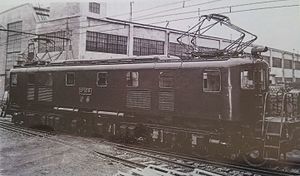JNR Class EF10
| Class EF10 | |||||||||||||||||||||||||||||||
|---|---|---|---|---|---|---|---|---|---|---|---|---|---|---|---|---|---|---|---|---|---|---|---|---|---|---|---|---|---|---|---|
 EF10 18 shortly after completion in 1938 | |||||||||||||||||||||||||||||||
| |||||||||||||||||||||||||||||||
| |||||||||||||||||||||||||||||||
| |||||||||||||||||||||||||||||||
| |||||||||||||||||||||||||||||||
TheClass EF10(EF10 hình)is anelectric locomotivebuilt for theJapanese Government Railwaysformerly operated on freight services in Japan from 1934 until 1983.
History
[edit]41 locomotives were built between 1934 and 1941 by the manufacturersHitachi,Kawasaki Heavy Industries,Kisha Seizo,Mitsubishi,andToshiba.[1]
Locomotive construction was divided into four batches, with further differences within individual batches as follows.[1]
EF10 1 - 16
[edit]Locomotives EF10 1 to 16 had bodies with similar styling to theClass ED16andClass EF53locomotives.[1]
-
EF10 1-16
-
A Class ED16 locomotive for comparison
EF10 17
[edit]EF10 17 was built in 1937 with a welded body and more rounded styling.[1]
-
EF10 17
EF10 18 - 19
[edit]Locomotives EF10 18 and 19 continued with the same rounded body styling as EF10 17, but used a similar bar frame bogie design to the first batch of locomotives.[1]
EF10 20 - 24
[edit]Locomotives EF10 20 to 24 continued with the same body design, but with a different ventilator arrangement.[1]
EF10 25 - 29
[edit]Locomotives EF10 25 to 29 had welded bodies, but reverted to a more angular design.[1]
EF10 30 - 33
[edit]Locomotives EF10 30 to 33 continued with the same welded angular body design, but used cast bogie frames.[1]
-
EF10 30-33
EF10 34 - 41
[edit]Locomotives EF10 34 to 41 used the original bar frame bogie design.[1]
Preservation
[edit]
EF10 35 was preserved in a park inMoji-ku, Kitakyushubefore being restored and moved to the newly opened Kyushu Railway History Museum in 2003, where it is preserved statically.[2]
Classification
[edit]The EF10 classification for this locomotive type is explained below.
- E: Electric locomotive
- F: Six driving axles
- 10: Locomotive with maximum speed 85 km/h or less
See also
[edit]References
[edit]- ^abcdefghiInoue, Koichi (1999).Quốc thiết cơ quan xe sự điển: Chưng khí ・ điện khí ・ディーゼル cơ quan xe 66 hình thứcQuốc thiết cơ quan xe từ điển[JNR Locomotive Encyclopedia] (in Japanese). Japan: Sankaido. pp. 84–85.ISBN978-4-381-10338-3.
- ^Sasada, Masahiro (25 November 2014).Quốc thiết &jr bảo tồn xe bách khoa toàn thư 2015-2016Quốc thiết &JR bảo tồn xe bách khoa toàn thư 2015-2016[JNR & JR Preserved Rolling Stock Complete Guide 2015-2016] (in Japanese). Tokyo, Japan: Ikaros Publications Ltd. p. 122.ISBN978-4863209282.
Further reading
[edit]- Thiết nói xe 輌ディテール・ファイル002 ひさし phó xe thể の EF10(1〜16)[Rolling Stock Detail File 002: Sun visor type EF10 (1 to 16)] (in Japanese). Japan: Neko Publishing Co., Ltd. September 2009.ISBN978-4777052622.
- Thiết nói xe 輌ディテール・ファイル 004: Hoàn hình xe thể の Ef10(17~24)Thiết nói xe 輌ディテール・ファイル004 hoàn hình xe thể の EF10 ( 17~24 )[Rolling Stock Detail File 004: Round-bodied EF10 (17 to 24)] (in Japanese). Japan: Neko Publishing Co., Ltd. November 2009.ISBN978-4777052707.
- Thiết nói xe 輌ディテール・ファイル007 hoàn hình xe thể の EF10 ( 25~41 )[Rolling Stock Detail File 007: Angular-bodied EF10 (25 to 41)] (in Japanese). Japan: Neko Publishing Co., Ltd. February 2010.ISBN978-4777052783.





